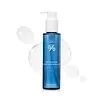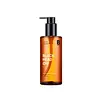What's inside
What's inside
 Key Ingredients
Key Ingredients

 Benefits
Benefits

 Concerns
Concerns

 Ingredients Side-by-side
Ingredients Side-by-side

Helianthus Annuus Seed Oil 44.3%
EmollientCetyl Ethylhexanoate
EmollientSorbeth-30 Tetraoleate
EmulsifyingSorbitan Sesquioleate
EmulsifyingCitrus Aurantium Dulcis Peel Oil
MaskingCitrus Paradisi Peel Oil
MaskingCitrus Aurantium Bergamia Fruit Oil
MaskingMacadamia Ternifolia Seed Oil
EmollientLimnanthes Alba Seed Oil
Skin ConditioningOlea Europaea Fruit Oil
MaskingSimmondsia Chinensis Seed Oil
EmollientCaprylic/Capric Triglyceride
MaskingTocopheryl Acetate
AntioxidantPentaerythrityl Tetra-Di-T-Butyl Hydroxyhydrocinnamate
AntioxidantWater
Skin ConditioningButylene Glycol
HumectantLactobacillus Ferment
Skin ConditioningLactobacillus Ferment Lysate
Skin ConditioningLactococcus Ferment Lysate
Skin ConditioningBifida Ferment Filtrate
Skin ConditioningBifida Ferment Lysate
Skin ConditioningSaccharomyces Ferment Filtrate
Humectant1,2-Hexanediol
Skin ConditioningCaprylyl Glycol
EmollientEthylhexylglycerin
Skin ConditioningLimonene
PerfumingLinalool
PerfumingHelianthus Annuus Seed Oil 44.3%, Cetyl Ethylhexanoate, Sorbeth-30 Tetraoleate, Sorbitan Sesquioleate, Citrus Aurantium Dulcis Peel Oil, Citrus Paradisi Peel Oil, Citrus Aurantium Bergamia Fruit Oil, Macadamia Ternifolia Seed Oil, Limnanthes Alba Seed Oil, Olea Europaea Fruit Oil, Simmondsia Chinensis Seed Oil, Caprylic/Capric Triglyceride, Tocopheryl Acetate, Pentaerythrityl Tetra-Di-T-Butyl Hydroxyhydrocinnamate, Water, Butylene Glycol, Lactobacillus Ferment, Lactobacillus Ferment Lysate, Lactococcus Ferment Lysate, Bifida Ferment Filtrate, Bifida Ferment Lysate, Saccharomyces Ferment Filtrate, 1,2-Hexanediol, Caprylyl Glycol, Ethylhexylglycerin, Limonene, Linalool
Glycine Soja Oil
EmollientTriethylhexanoin
MaskingEthylhexyl Palmitate
EmollientPEG-20 Glyceryl Triisostearate
EmollientIsopropyl Myristate
EmollientIsohexadecane
EmollientEthylhexyl Stearate
EmollientPolyisobutene
Dicaprylyl Ether
EmollientIsononyl Isononanoate
EmollientCaprylic/Capric Triglyceride
Masking1,2-Hexanediol
Skin ConditioningCitrus Limon Peel Oil
MaskingCitrus Aurantium Dulcis Oil
MaskingCitrus Limon Fruit Oil
AstringentCymbopogon Schoenanthus Oil
MaskingGeranium Maculatum Oil
MaskingPentaerythrityl Tetra-Di-T-Butyl Hydroxyhydrocinnamate
AntioxidantCymbopogon Nardus Oil
MaskingCitrus Reticulata Leaf Oil
MaskingPrunus Armeniaca Kernel Oil
MaskingVetiveria Zizanoides Root Oil
MaskingMelaleuca Alternifolia Leaf Oil
AntioxidantMoringa Oleifera Seed Oil
EmollientWater
Skin ConditioningButylene Glycol
HumectantCentella Asiatica Extract
CleansingHouttuynia Cordata Extract
Skin ConditioningPentylene Glycol
Skin ConditioningEthylhexylglycerin
Skin ConditioningTocopherol
AntioxidantLimonene
PerfumingCitral
PerfumingGlycine Soja Oil, Triethylhexanoin, Ethylhexyl Palmitate, PEG-20 Glyceryl Triisostearate, Isopropyl Myristate, Isohexadecane, Ethylhexyl Stearate, Polyisobutene, Dicaprylyl Ether, Isononyl Isononanoate, Caprylic/Capric Triglyceride, 1,2-Hexanediol, Citrus Limon Peel Oil, Citrus Aurantium Dulcis Oil, Citrus Limon Fruit Oil, Cymbopogon Schoenanthus Oil, Geranium Maculatum Oil, Pentaerythrityl Tetra-Di-T-Butyl Hydroxyhydrocinnamate, Cymbopogon Nardus Oil, Citrus Reticulata Leaf Oil, Prunus Armeniaca Kernel Oil, Vetiveria Zizanoides Root Oil, Melaleuca Alternifolia Leaf Oil, Moringa Oleifera Seed Oil, Water, Butylene Glycol, Centella Asiatica Extract, Houttuynia Cordata Extract, Pentylene Glycol, Ethylhexylglycerin, Tocopherol, Limonene, Citral
 Reviews
Reviews

Ingredients Explained
These ingredients are found in both products.
Ingredients higher up in an ingredient list are typically present in a larger amount.
1,2-Hexanediol is a synthetic liquid and another multi-functional powerhouse.
It is a:
- Humectant, drawing moisture into the skin
- Emollient, helping to soften skin
- Solvent, dispersing and stabilizing formulas
- Preservative booster, enhancing the antimicrobial activity of other preservatives
Butylene Glycol (or BG) is used within cosmetic products for a few different reasons:
Overall, Butylene Glycol is a safe and well-rounded ingredient that works well with other ingredients.
Though this ingredient works well with most skin types, some people with sensitive skin may experience a reaction such as allergic rashes, closed comedones, or itchiness.
Learn more about Butylene GlycolThis ingredient is an emollient, solvent, and texture enhancer. It is considered a skin-softener by helping the skin prevent moisture loss.
It helps thicken a product's formula and makes it easier to spread by dissolving clumping compounds.
Caprylic Triglyceride is made by combining glycerin with coconut oil, forming a clear liquid.
While there is an assumption Caprylic Triglyceride can clog pores due to it being derived from coconut oil, there is no research supporting this.
Learn more about Caprylic/Capric TriglycerideEthylhexylglycerin (we can't pronounce this either) is commonly used as a preservative and skin softener. It is derived from glyceryl.
You might see Ethylhexylglycerin often paired with other preservatives such as phenoxyethanol. Ethylhexylglycerin has been found to increase the effectiveness of these other preservatives.
Limonene is a fragrance that adds scent and taste to a formulation.
It's found in the peel oil of citrus fruits and other plants such as lavender and eucalyptus. The scent of limonene is generally described as "sweet citrus".
Limonene acts as an antioxidant, meaning it helps neutralize free radicals.
When exposed to air, oxidized limonene may sensitize the skin. Because of this, limonene is often avoided by people with sensitive skin.
The term 'fragrance' is not regulated in many countries. In many cases, it is up to the brand to define this term. For instance, many brands choose to label themselves as "fragrance-free" because they are not using synthetic fragrances. However, their products may still contain ingredients such as essential oils that are considered a fragrance.
Learn more about LimonenePentaerythrityl Tetra-Di-T-Butyl Hydroxyhydrocinnamate (long name, huh?) is a synthetic antioxidant.
It is used to help stabilize other antioxidants or prevent the color from changing in a product.
As an antioxidant, it helps fight free-radical molecules. Free-radical molecules are capable of damaging our cells and other genetic material. Thus, antioxidants may reduce the signs of aging.
This ingredient is oil-soluble.
Learn more about Pentaerythrityl Tetra-Di-T-Butyl HydroxyhydrocinnamateWater. It's the most common cosmetic ingredient of all. You'll usually see it at the top of ingredient lists, meaning that it makes up the largest part of the product.
So why is it so popular? Water most often acts as a solvent - this means that it helps dissolve other ingredients into the formulation.
You'll also recognize water as that liquid we all need to stay alive. If you see this, drink a glass of water. Stay hydrated!
Learn more about Water